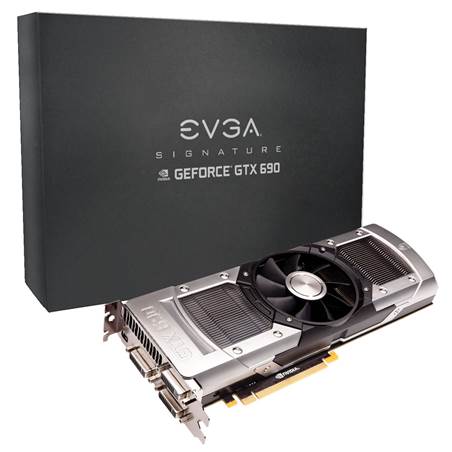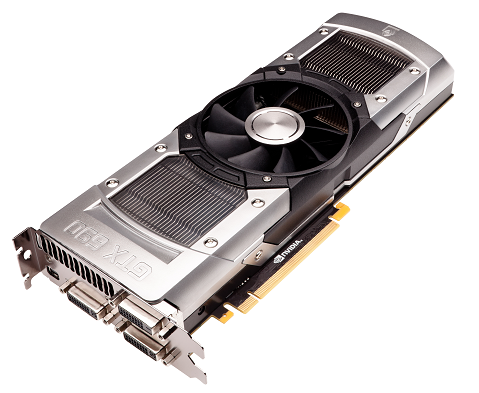When Nvidia launched the GTX 680 back in
May, it handily cleaned the AMO HO 7970’s clock, but that wasn’t enough for
Nvidia (or us, to be honest). So Nvidia did what any rational power-hungry
company would do, and married two GK1O4 GPUs to a single PCB, connected them
with a 48-lane PLX PCIe 3.0 bridge chip, and dubbed it the GTX 690. It now
reigns as the only current-gen dual-GPU card available, since AMO’s dual HO
7970 card never officially materialized. Though we’ve reviewed the GTX 690
before, and also chose it for our lust-inspiring Dream Machine 2012, we had
previously sampled the Asus board, so this month we’re checking out the other
GeForce GTX 690, from EVGA. The two cards are clocked the same—slightly lower
than a stock-clocked GTX 680 on each GPU—but the EVGA card is $50 less
expensive.

The
two cards are clocked the same slightly lower than a stock-clocked GTX 680 on
each GPU but the EVGA card is $50 less expensive.
Like the other GTX 690 cards we’ve seen,
the EVGA card looks precisely how a $1,000 video card should look, because if
you’re dropping a grand on a GPU you don’t want a chintzy plastic shroud or an aluminum
heatsink. Oh, no you want some cheese on that burger. The GTX 690 is
practically dripping, starting with the illuminated GeForce GTX logo on the
side of the card that glows lime green when the card has power; it’s enough to
make us want to bust out the Dremel tool and install a case window. The second
tricked-out bit is the cooling mechanism itself, which is crafted from chromium
plated cast aluminum and feels as solid as a section of rebar.

The
second tricked-out bit is the cooling mechanism itself, which is crafted from
chromium plated cast aluminum and feels as solid as a section of rebar.
The business end of the GTX 690 features
two full blown GK1O4 OPUs with nothing changed from their configuration in the
GTX 680 (aside from the previously mentioned under clocking). This 11-inch card
is hoarding a total of 3,072 CUDA cores, 64 ROPs, 256 texture units, and 4GB of
RAM. Given its specs, it’s not surprising to see how well it performs, but in
comparison to the Asus card and two GTX 680s in SLI, it gets interesting. The
EVGA card was mostly faster than the Asus card, but we chalk up some of that to
improved drivers since our Last review. The Shogun 2 differential is from a
game patch, however, as that game suddenly jumped l5fps in our tests a few
weeks ago regardless of driver. As you can see, though, the EVGA is not quite
as fast as a true SLI setup, but it will produce less heat and only requires
two 8-pin PSU connectors instead of four 6-pin connectors, so you don’t need to
upgrade your PSU to run the GTX 690. We’ve even run it on a 650W PSU with zero
problems. AIL in all, it’s pretty damn impressive.

Evga
GTX 690
If you need one more reason to consider a
GTX 690, bank account willing, it’s the fastest single card in existence by a
long shot. And if your bank account is in the Cayman Islands, you can always
run two in SLI just like Dream Machine 2012.